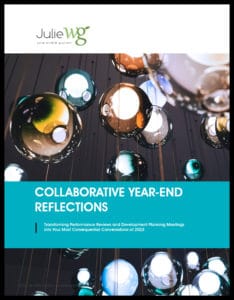 Over the past year, development has finally gotten the attention it deserves. As it turns out, development is both a driver of attrition and an incentive for recruitment. So, whether they’re coming or going, employees prioritize opportunities for growth – and leaders committed to cultivating a robust and stable staff must prioritize it too.
Over the past year, development has finally gotten the attention it deserves. As it turns out, development is both a driver of attrition and an incentive for recruitment. So, whether they’re coming or going, employees prioritize opportunities for growth – and leaders committed to cultivating a robust and stable staff must prioritize it too.
But prioritizing development doesn’t mean engaging in check-the-box processes, annual planning or even carving out five minutes from each one-on-one to talk about anything but performance. It means weaving growth conversations into the fabric of daily life. It means taking the communication skills leaders already have to the next level by using them with the intention to catalyze development.
These three meta-communication strategies – or conversation catalysts – allow highly effective leaders to mine all the ownership, confidence, and clarity development conversations have to offer.
- Draw It Out
- Lift Them Up
- Nail It Down
Draw It Out
At the core of effective development dialogue is facilitating the insights, wisdom, and energy that exist within each individual. Development is steadfast when personal and self-driven. And the good news is that employees have plenty of thoughts and ideas on the subject. Too frequently, though, these ideas are left unspoken as well-meaning leaders suggest goals, strategies, and actions for others to follow. When employees are encouraged to play an active role and volunteer their best thinking, they feel more capable, experience greater ownership for their development, and demonstrate greater commitment to action.
Want to get better at drawing insights out from others? Try these success practices:
- Replace telling with asking.
- Listen for feelings as well as content.
- Use prompts like, ‘What do you think?’, “How might that work?’, and ‘Say more’.
- Befriend silence and apply it generously.
- Save your ideas for later (if ever).
Lift Them Up
Development is only possible when others feel seen, heard, and valued. Growth means stepping outside of one’s comfort zone, challenging what’s known, experimenting, and likely failing before getting it right. Some may feel safer (at least in the short-term) sitting on the sidelines. But employees who enjoy a genuine connection are willing to take a risk. Those who feel appreciated as human beings and not just workers, respected, and honored have the confidence to venture into something new, knowing they have the internal resources and external support to be successful.
Want to get better at lifting others up? Try these success practices:
- Invest in relationships and getting to know the whole person.
- Celebrate strengths and talents.
- Recognize effort, struggles, and results.
- Demonstrate respect and maintain self-esteem.
- Invite feedback about what’s working and could work better.
Nail it Down
Each development conversation is an opportunity to create the clarity that keeps others moving forward over time. Sometimes this means clarifying interests, aspirations, or actions. Other times, it’s translating development experiences into concrete learning. And still other times, it’s jointly determining next steps to help others remain engaged and growing. But each and every time, employees will benefit from your efforts to crystalize understanding and inspire action.
Want to get better at nailing it down? Try these success practices:
- Summarize highlights, key points, and agreements.
- Clarify confusion or open issues.
- Co-create at least one small step forward.
- Determine what others need to succeed.
- Check in on emotions (since feelings drive action).
Development isn’t an event but rather a spirit leaders bring to their relationships with others. And that spirit manifests itself in the way leaders deploy the range of communication skills they’ve accumulated through the years. Intentionally facilitating and drawing the wisdom out of others, lifting them up, and ensuring clarity and action by nailing things down creates an environment where there will be a lot fewer employees coming and going – and a lot more growing.

These catalysts support both development and performance conversations. Download our e-guide for timely advice for transforming year-end performance reviews into your most consequential conversations of 2022.
This post was originally published on SmartBrief.
